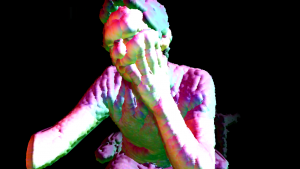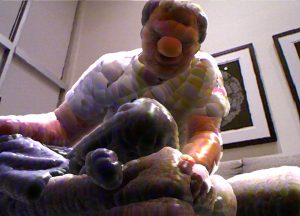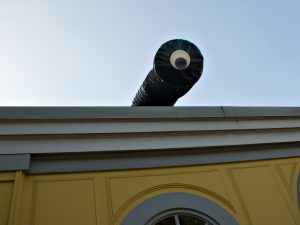// Simin Li
// Section C
// siminl@andrew.cmu.edu
// Project 02
var eyeSize = 20;
var faceWidth = 222;
var faceHeight = 260;
var a = 180;
var b = 160; //coordinates of drop 2
var k = 8; //size of drop 2
var i = 0;
var c = 175;
var d = 163;//coordinates of drop 1
var m = 18; //size of drop 1
var j = 0;
var noseHeight = 40;
var rd = 171;
var gn = 31;
var bl = 31;// RGB of lip color
function setup() {
createCanvas(640, 480);
}
function draw() {
background(193,222,239); //blue
noStroke();
fill(248,213,178); // arm
triangle(0, 300, 0, 0, 550 ,0)
fill(240,174,164); //mosquito bite
ellipse( 150, 120, 30, 50);
fill(249,223,213 );
ellipse( 150, 120, 6, 6);
fill(240,174,164); //mosquito bite
ellipse( 300, 70, 40, 20);
fill(249,223,213 );
ellipse( 299, 70, 6, 6);
var noseY = height / 2 - noseHeight; //y of nose bridge point
var noseX = width / 2 - faceWidth * 0.5 - noseHeight * 0.3; //x ofnose tip
var nosey = height / 2 - faceHeight / 3; //y of nose tip
fill(254,242,195 );
triangle(noseX,nosey, width / 2, height / 2 - faceHeight / 2, width / 2, noseY);//nose
ellipse(width / 2, height / 2, faceWidth, faceHeight); //face
var eyeRX = width / 2 + faceWidth * 0.25; //positions the mouth
fill(0) ; // eye liner
arc(eyeRX, height / 2 - 30 , eyeSize + 17, eyeSize + 17,PI ,TWO_PI,CHORD);
noStroke();
fill(252,253,255) ; // eye whites
ellipse(eyeRX, height / 2 - 30, eyeSize, eyeSize);
fill(0) ; // pupil
arc(eyeRX, height / 2 - 30, eyeSize - 15, eyeSize - 15, QUARTER_PI,TWO_PI,PIE);
var mouthWidth = width / 2 - faceWidth * 0.25; //positions the mouth
stroke(rd,gn,bl);
strokeWeight(15.0);
fill(228,95,136 ) ; //mouth
ellipse(mouthWidth,height / 2 + 15,faceHeight / 4,faceWidth / 4);
noStroke(); //blood drop 1
fill(225,39,39);
beginShape();
curveVertex(c, d);
curveVertex(c + (1 / 2) * m, d + m * 2);
curveVertex(c + (3 / 4) * m, d + m * 3);
curveVertex(c, d + 4 * m);
curveVertex(c - (3 / 4) * m, d + m * 3);
curveVertex(c - (1 / 2) * m, d + m * 2);
endShape(CLOSE);
d = d + 2.5;
j ++; // so drop can return to origin
if ( d > 420)
{ d = d - j * 2.5;
j = 0; }
noStroke(); //(dark) blood drop 2
fill(138,24,24);
beginShape();
curveVertex(a, b);
curveVertex(a + (1 / 2) * k, b + k * 2);
curveVertex(a + (3 / 4) * k, b + k * 3);
curveVertex(a, b + 4 * k);
curveVertex(a - (3 / 4) * k, b + k * 3);
curveVertex(a - (1 / 2) * k, b + k * 2);
curveVertex(a, b);
endShape(CLOSE);
b = b + 2.9;
i ++; // so drop can return to origin
if ( b > 420)
{ b = b - i * 2.9;
i = 0; }
fill(0);
text("this mosquito is hungry for blood..", 410, 465);
}
function mousePressed() {
faceWidth = random(200, 300); //changes the shape of the face
faceHeight = random(200, 300);
eyeSize = random( 12, 60);
noseHeight = random(30, faceHeight / 2 );
rd = random(0, 255);
gn = random(0, 255);
bl = random(0, 255);
}
This project turned out very different from what I originally planned. I wanted to make a person with a nosebleed and when I got to making the nose, the pointy quality of it inspired me to make a mosquito sucking blood. I am very happy with my decision.
![[OLD – FALL 2016] 15-104 • COMPUTING for CREATIVE PRACTICE](../../../../wp-content/uploads/2020/08/stop-banner.png)

 http://roberthodgin.com/portfolio/work/body-dysmorphia/
http://roberthodgin.com/portfolio/work/body-dysmorphia/ The Snout is a robotic arm with a googly eye on top that reacts to human movement by doing what seems like a double take. This project was done by Golan Levin, Lawrence Hayhurst, Steven Benders and Fannie White in 2008. It took 5 months and dealt with difficult problems like getting the 600-kilo robot on the roof for display. The software for this robot was developed in 3 weeks using toolkits such as openFrameworks. Professor Levin explains that thisproject was inspired by a performance by Mummenschanz when he was 6 years old. The performers were dressed in worm like tubes that look similar to The Snout. What is interesting about this interactive project is that it causes the illusion that it is confused. It is difficult making an animated character seem confused in a normal setting, not to mention doing what professor Levin calls “real-time animation” with a huge robot. This project addresses only one emotion. In future projects, robots should be able to display other emotions like joy, anger, sadness and fear etc. This may be a difficult task, requiring artists, computer scientists and Psychologist to work together, but something like The Snout project had been done almost 50 years ago. In 1970, Edward Ihnatowicz made a robot called “Senster” that turned to you when you clapped. It was a simple reaction but it shed light on what we are able to do with the technology we have today.
The Snout is a robotic arm with a googly eye on top that reacts to human movement by doing what seems like a double take. This project was done by Golan Levin, Lawrence Hayhurst, Steven Benders and Fannie White in 2008. It took 5 months and dealt with difficult problems like getting the 600-kilo robot on the roof for display. The software for this robot was developed in 3 weeks using toolkits such as openFrameworks. Professor Levin explains that thisproject was inspired by a performance by Mummenschanz when he was 6 years old. The performers were dressed in worm like tubes that look similar to The Snout. What is interesting about this interactive project is that it causes the illusion that it is confused. It is difficult making an animated character seem confused in a normal setting, not to mention doing what professor Levin calls “real-time animation” with a huge robot. This project addresses only one emotion. In future projects, robots should be able to display other emotions like joy, anger, sadness and fear etc. This may be a difficult task, requiring artists, computer scientists and Psychologist to work together, but something like The Snout project had been done almost 50 years ago. In 1970, Edward Ihnatowicz made a robot called “Senster” that turned to you when you clapped. It was a simple reaction but it shed light on what we are able to do with the technology we have today.